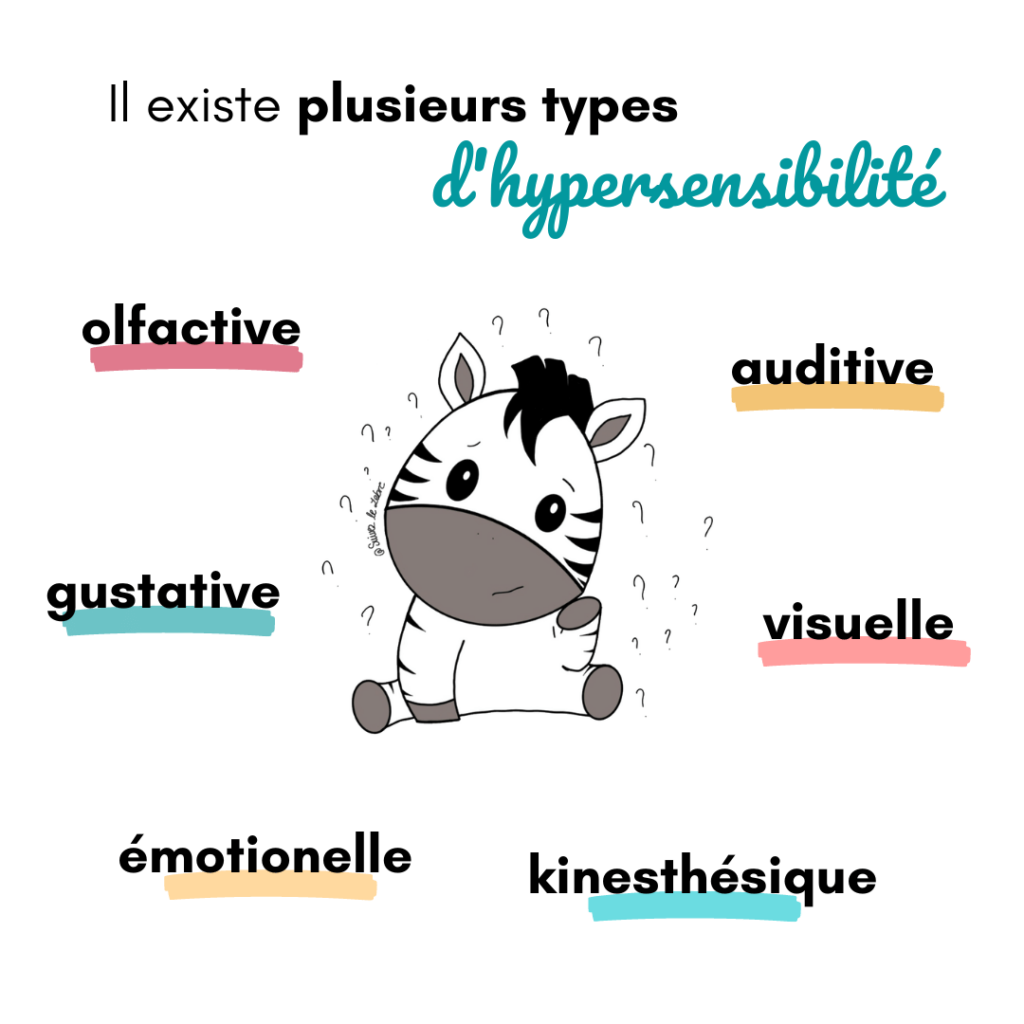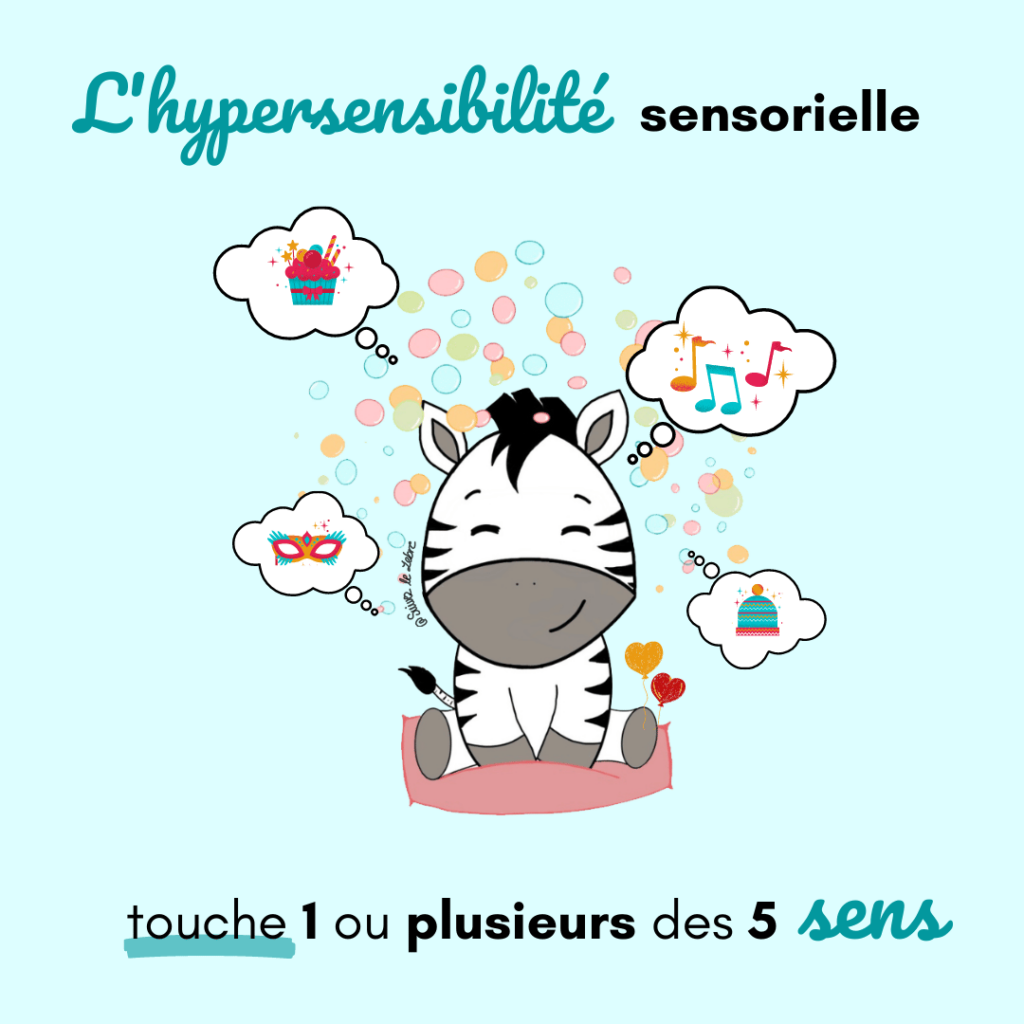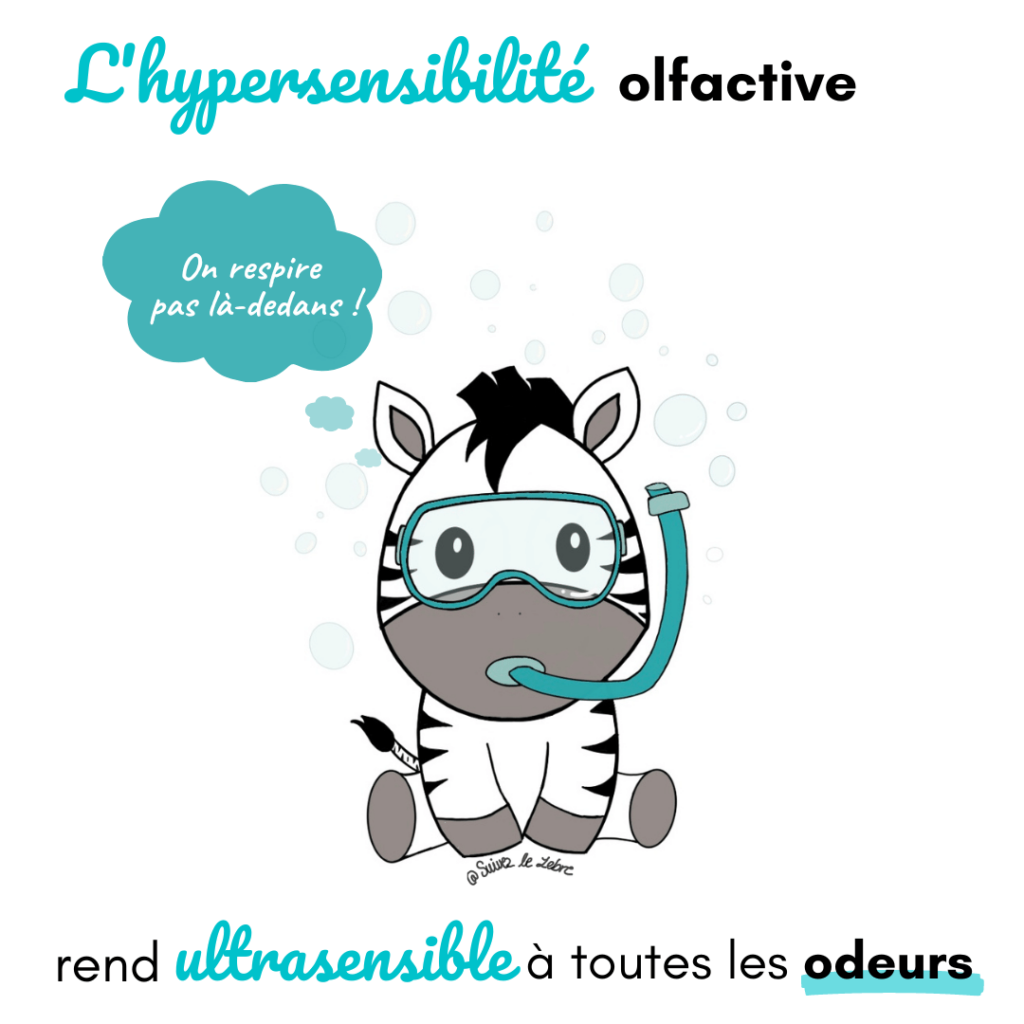Welcome to Suivez le Zèbre, the first blog to democratize giftedness(High Learning Potential) and neurodiversity. Are you interested in hypersensitivity? Let’s try to answer your questions together!
What does it mean to be hypersensitive? Are we hypersensitive in all 5 senses or just one? Is hypersensitivity a disease? Is it innate or acquired?
WHAT IS HYPERSENSITIVITY?
Hypersensitivity manifests itself in different ways:
- emotional hypersensitivity
- sensory hypersensitivity
- environmental hypersensitivity
People are also referred to as“highly sensitive” or“ultrasensitive“, with an exacerbated, more intense and highly developed sensitivity.

This will manifest itself in a hypersensoriality of the 5 senses that expresses itself differently in each person. For example: seams that hurt, repetitive noises that annoy, sensitivity to strong odor, hearing your heartbeat in certain parts of your body, such as in your ear at bedtime.
For others, hypersensitivity means taking everything to heart, being hyperemotional and feeling like an emotional sponge. As for some hypersensitive people, it’s a combination of hypersensitivity and hyperemotionality.
In Hypersensible we talk a lot about sensoriality, because it’s just as much a problem as having highly developed emotions.
Fanny Marais, high sensitivity coach

In hypersensitivity, everything is intertwined, we experience everything in excess, which is why many hypersensitive people have both hypersensoriality and hyperemotionality. Hypersensoriality is a modern notion that used to be called hyperesthesia.
Is hypersensitivity innate or acquired?
Hypersensitivity can be seen as a combination of innate and acquired factors. Some people may have a genetic predisposition to hypersensitivity, but it can also be influenced by environmental factors such as stress, life experiences and trauma.
Hypersensitivity can be triggered by :
- an accident
- an operation
- a bereavement
- a break
- a treatment
- post-traumatic stress
- an event
- etc
It may also be linked to specific cognitive functioning. People on the autism spectrum are particularly sensitive. A large proportion of people with High Learning Potential are also hypersensitive, even though there is no consensus in the neuroscientific community and the correlation between hypersensitivity and giftedness has never been demonstrated.
Would you like to know if you could be hypersensitive? Don’t hesitate to take our test. You’ll be asked to make a symbolic contribution by offering the team a coffee (1coffee = 1 euro).

Hypersensitivity is not a uniformly defined condition. It can evolve over time and be influenced by new experiences and life changes.
There can be great variability in the way different people experience and manage it on a day-to-day basis.
In the event of increased difficulties linked to your hypersensitivity, it’s important to consult a health professional for a precise diagnosis and treatment tailor-made to your needs.
HYPERSENSITIVITY OF THE 5 SENSES
Sensory hypersensitivity leads to stronger, more intense reactions to the stimuli around us. Each of your senses can be impacted.

Olfactory hypersensitivity
Olfactory hypersensitivity is a sensory disorder characterized by an increased and often unpleasant perception of odors. People with olfactory hypersensitivity are often very sensitive to odors that may be tolerable for others. This olfactory hypersensitivity can cause distress and physical discomfort such as headaches, nausea and dizziness.

Causes of olfactory hypersensitivity
Olfactory hypersensitivity can be caused by several factors:
- Nasal disorders
- rhinitis
- sinusitis
- nasal polyps
- chronic diseases
- depression
- anxiety
- Neurodevelopmental disorders
- autism spectrum disorders (ASD)
- including Asperger’s syndrome (ASD)
- attention deficit hyperactivity disorder (ADHD)
- Neurological disorders
- Alzheimer’s disease
- Parkinson’s disease
- multiple sclerosis
- obsessive-compulsive disorder (OCD)
- head injuries
- certain toxic substances
- solvents
- heavy metals
- medicines

When you consider thatone in three people with Giftedness has ADHD (attention deficit hyperactivity disorder), this may explain why many gifted people feel hypersensitive, despite the lack of consensus in the neuroscientific community.
How is olfactory hypersensitivity treated?
Treatment of olfactory hypersensitivity may vary depending on the underlying cause. Several treatments can be combined, such as cognitive-behavioral therapy to help manage emotional reactions to odor, and environmental modification to reduce exposure to unpleasant odors, as well as treatment with medication or even nasal surgery. Personal development can be used as a complement to find emotional balance and bring you greater comfort in your daily life.

If you suffer from olfactory hypersensitivity, it’s important to consult a doctor, as it may be a symptom of another health problem and require specific, tailor-made treatment.
Tactile or kinesthetic hypersensitivity
Touch sensory sensitivity or kinaesthesia is a sensory disorder characterized by an increased and often unpleasant perception of tactile sensations. People with tactile or kinaesthetic hypersensitivity can be very sensitive to textures, movements and pressure on their skin.

Touch sensory sensitivity, which can cause distress and physical discomfort such as headaches, bodily pains, discomfort, tingling, burning, itching and dizziness.
Touch sensory sensitivity can be misunderstood or misinterpreted by those around you, especially in your relationship. Indeed, tactile hypersensitivity can be restrictive when it comes to intimacy.

If you suffer from tactile hypersensitivity and have difficulty with caresses or touching certain parts of your body, it’s important to talk about it with the person who shares your life so that you can fully develop in your relationship. Remember that no matter what your situation, whether you’re single, in a relationship or married, your body belongs to you. If you don’t feel ready for intimacy, the person who loves you should respect your decision.
Causes of tactile hypersensitivity
Touch sensory sensitivity may be associated with other disorders such as :
- neurodevelopmental disorders
- autism spectrum disorders
- including Asperger’s syndrome (part of ASD autism spectrum disorder)
- attention deficit hyperactivity disorder (ADHD)
- generalized anxiety disorder (GAD)
- neurological disorders
- peripheral neuropathy
- multiple sclerosis
- lupus
- central nervous system disorders
- depression
- anxiety
- obsessive-compulsive disorder (OCD)
- head injuries
- certain chronic and skin diseases
- diabetes
- eczema
- psoriasis
How is tactile hypersensitivity treated?
The treatment of tactile hypersensitivity (kinesthetic) can include the cognitive-behavioural therapy to help manage emotional reactions to tactile stimulation, participation in relaxation activities linked to personal development, such as yoga and meditation, as well as environmental modifications to reduce unpleasant tactile stimuli in everyday life.

If you suffer from hypersensitivity to touch, it’s important to consult a healthcare professional to assess and treat this condition, as it can interfere with your daily life. A doctor, psychologist or sex therapist may be recommended to help you reconcile your hypersensitivity with your everyday life.
Auditory hypersensitivity
Auditory hypersensitivity, also known as hyperacusis, is a hearing disorder characterized by an increased and often unpleasant perception of sounds. People with auditory hypersensitivity may be highly sensitive to sounds that may be tolerable to others, which can cause distress and physical discomfort such as headaches, nausea and dizziness.

Causes of hyperacusis
Hearing hypersensitivity can be caused by several factors:
- inner ear disorders
- Tinnitus
- deafness
- dizziness
- neurodevelopmental disorders
- autism spectrum disorders
- including Asperger’s syndrome (part of ASD autism spectrum disorder)
- attention deficit hyperactivity disorder (ADHD)
- generalized anxiety disorder (GAD)
- central nervous system disorders
- depression
- anxiety
- obsessive-compulsive disorder (OCD)
- head injuries
- ear injuries
- chronic diseases
- multiple sclerosis
- lupus
- diabetes
- etc
- Poisoning
- solvents
- heavy metals
- medicines
How is auditory hypersensitivity treated?
Treatment of auditory hypersensitivity may vary depending on the underlying cause. It can include:
- cognitive behavioral therapy (CBT ) helps change the way a person reacts to sound by teaching stress management and relaxation techniques
- Sound therapy consists of gradually getting patients used to the sounds that disturb them, using devices such as special headphones that produce sounds at controlled volume levels.
- medication can help reduce symptoms
- cochlear implant therapy may be recommended in the most severe cases to replace hearing loss and help reduce symptoms
- auditory therapy can help reinforce listening skills and improve tolerance to sound
- personal development for greater comfort in everyday life

If you suffer from auditory hypersensitivity, it’s important to consult a doctor, as it may be a symptom of another health problem. If your hypersensitivity is too much of a handicap in your day-to-day life, then a tailor-made, specific treatment will help you find the right solutions to make your life more comfortable again.
Light or ocular hypersensitivity
Visual or light hypersensitivity is characterized by an increased and often unpleasant perception of visual stimuli. People with light hypersensitivity can be highly sensitive to light, color, movement and visual complexity, which can cause distress and discomfort such as headaches, nausea and dizziness.

What causes ocular hypersensitivity ?
This condition may be associated with other disorders such as :
- neurodevelopmental disorders
- autism spectrum disorders
- including Asperger’s syndrome (part of ASD autism spectrum disorder)
- attention deficit hyperactivity disorder (ADHD)
- generalized anxiety disorder (GAD)
- certain illnesses
- obsessive-compulsive disorder (OCD)
depression - multiple sclerosis
- lupus
- diabetes
- eye disorders
- dry eyes
- conjunctivitis
- eye allergies
- corneal ulcers
- sensitivity to light (photophobia)
- frequent headaches
- eye fatigue syndrome
- prolonged exposure to screens
- eye injuries
- etc
How is light hypersensitivity treated?
Treatment of light hypersensitivity may be considered depending on the symptoms. Behavioral and environmental therapy can help reduce unpleasant light stimuli by adapting your daily routine.
Vision therapy is an approach that helps improve the eye’s ability to process visual information . This can include specific visual exercises and the use of visual devices such as special glasses.
Personal development: meditation, yoga and deep breathing can help reduce the stress and tension associated with light hypersensitivity.
Certain medications can help relieve the symptoms of light hypersensitivity, such as analgesics, anti-inflammatories and anti-nausea drugs.

If you suffer from light hypersentivity, it’s important to consult a doctor or opthalmologist, as it may be a symptom of another health problem. If your hypersensitivity is too much of a handicap in your day-to-day life, then a tailor-made, specific treatment will help you find the right solutions to make your life more comfortable again.
Taste hypersensitivity
Dysgeusia is a disorder of taste perception characterized by an excessive response to food flavors and textures. People with taste hypersensitivity may be highly sensitive to flavors that may be tolerable to others, causing distress and discomfort such as vomiting, difficult swallowing and reduced food intake.

Causes of taste hypersensitivity
Dysgeusia can be caused by several factors, including:
- disorders of saliva regulation
- neurological disorders
- Tourette’s syndrome
- Parkinson’s disease
- multiple sclerosis
- neurodevelopmental disorders
- autism spectrum disorders
- including Asperger’s syndrome (part of ASD autism spectrum disorder)
- attention deficit hyperactivity disorder (ADHD)
- generalized anxiety disorder (GAD)
- mouth diseases
- stomatitis
- oral candida
- ulcers
- drug side effects
- stress and anxiety
- nutrient deficiency
- iron deficiency
- zinc deficiency
How is taste hypersensitivity treated?
Treatment for taste hypersensitivity can include behavioral therapy to help manage emotional reactions to food flavors. If you suffer from taste hypersensitivity , you may want to consider desensitization therapy. It involves gradually exposing people to foods that bother them, which can help reduce hypersensitivity to these foods.
We also advise you to adopt a healthy, balanced diet to help improve your symptoms. Dietary modifications such as preparing meals with more tolerable flavors and textures will help you improve your daily routine. Oral hygiene also has a significant impact on taste hypersensitivity . Regular dental check-ups are essential.
Certain medications can help reduce the symptoms of taste hypersensitivity, such as anticonvulsants, antianxiety drugs and antidepressants.

If you suffer from taste hypersensitivity, it’s important to consult a doctor, dentist or allergist to assess its degree and treat it. Taste hypersensitivity can interfere with your daily and social life, and can have an impact at work or in your social relationships (invitations to eat out or at relatives’ homes), sometimes requiring specific intervention.
Emotional hypersensitivity
Emotional hypersensitivity describes heightened sensitivity to the emotions and feelings of others. People who are considered emotionally hypersensitive can be greatly affected by the emotions and behaviors of the people around them.

This can make them more vulnerable to sadness, anxiety and stress, but can also help them develop a strong capacity for empathy and compassion for others.
Emotional hypersensitivity can be a challenge to manage, but there are ways to work on yourself to better manage this sensitivity and avoid overreaction.
Personal development is a fantastic tool for turning emotional hypersensitivity into strength. It can be helpful to practice stress management and meditation techniques, maintain a balanced diet and exercise regularly, and work with a therapist to fully understand and apprehend your emotions and behaviors.
Is hypersensitivity a disease?
Hypersensitivity is not considered a disease, but rather a state or condition which, as we have just seen, may be the result of other disorders or medical conditions.

Hypersensitivity can be associated with the 5 senses, but it can also be expressed by intense, exacerbated, overflowing emotions.
Hypersensitivity is not just a constraining condition! It helps develop exceptional senses such as sensitivity, empathy and creativity.
By working on your hypersensitivity management and learning to deal with environmental stimuli, you can greatly improve your self-confidence and self-esteem and lead a rich, fulfilling life.
Would you like to find out more about emotional hypersensitivity?
You can also find more information, resources and tools on Gifted in Mel POINAS‘ book. With a lot of humor, Mel tells the story of the discovery of her giftedness and the routines she put in place to finally find her place!

Le livre
Écrit par une HPI !
Un témoignage et des solutions concrètes pour découvrir, comprendre et apprendre à vivre en étant HPI.

To find out more about hypersensitivity
- Our tips for managing your emotions
- Testimony of Simon, Hypersensitive
- Is a gifted person necessarily hypersensitive?
- Learning to manage your hypersensitivity when you are gifted
- Zebra or Hypersensitive, HEP, Asperger’s, Bipolar, Borderline?















